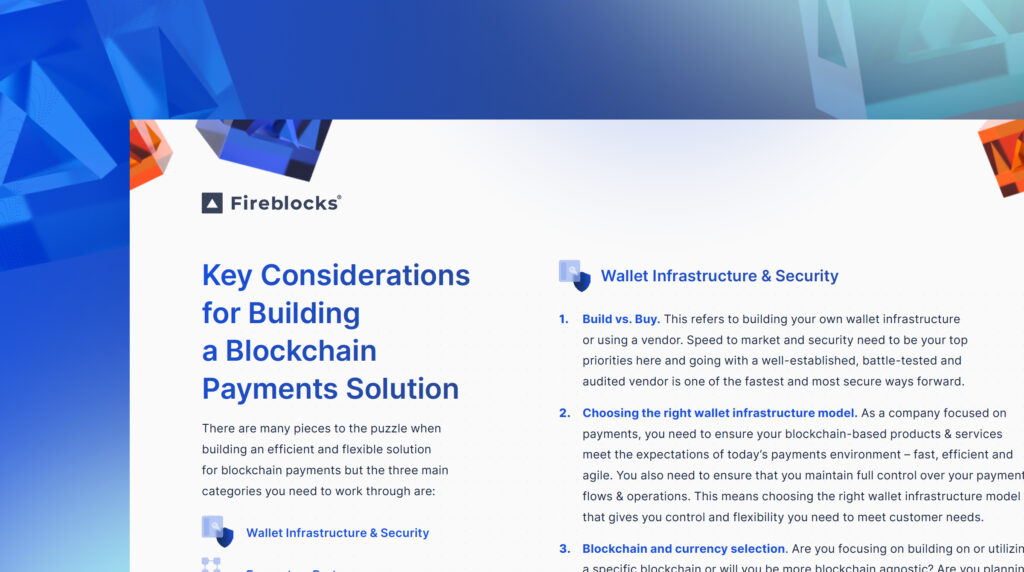Your organization has identified a business and revenue opportunity to incorporate blockchain into your offering (or maybe launch a new product line that involves digital assets), and now you’re ready to implement this technology into a product offering. The question now is, “Where do we begin?”
Ideally, your team will be working with partners and products that can easily fit into your existing tech stack and operational workflows.
This blog provides a short guide on the main considerations to help you get started building blockchain-based payments applications, products and services.
If you’re looking for more about the WHAT (e.g., where exactly does the revenue lie with blockchain, what are the top use cases for this technology, etc.), please review Unlock new revenue streams with blockchain payments use cases.
Key considerations for building a blockchain payments solution
There are many pieces to the puzzle when building an efficient and flexible solution for blockchain payments but the three main categories you need to work through are Wallet Infrastructure and Security, Ecosystem Partners, and Operational Workflows.
Wallet Infrastructure and Security
Build refers to the solution architecture, wallet infrastructure, connectivity to blockchain network(s), and orchestration of your solution. For whichever use case your organization settles on, you will need to decide if you are going to custody funds on behalf of customers or not, and what type of wallet infrastructure is best suited for that purpose.
One other item to touch on in the Build phase is security. Security in crypto and digital assets is paramount; if you’re interested in learning more about how to build operational security into the fabric of your product and service from Day 0, review our guide, Four Operational Security Pillars for Building Blockchain Apps.
Let’s first look at the top considerations in the Build phase:
Consideration 1: Build vs. Buy.
This refers to building your own wallet infrastructure or using a vendor. Speed to market and security need to be your top priorities here and going with a well-established, battle-tested and audited vendor is one of the fastest and most secure ways forward.
Consideration 2: Choosing the right wallet infrastructure model.
As a company focused on payments, you need to ensure your blockchain-based products and services meet the expectations of today’s payments environment – fast, efficient and agile. You also need to ensure that you maintain full control over your payment flows and operations. This means choosing the right wallet infrastructure model that gives you control and flexibility you need to meet customer needs.
Consideration 3: Blockchain and currency selection.
Are you focusing on building on or utilizing a specific blockchain or will you be more blockchain agnostic? Are you planning to work only with USDC or also USDT and PUSD? Keep in mind that as the world moves towards more blockchain interoperability, you will likely need wallet infrastructure that can support near-term and future use cases, chains and tokens.
Ecosystem Partners
Now that you’ve identified considerations around wallet infrastructure the next step is to consider the ecosystem required to be successful. Crypto and digital asset products and services can launch quickly, and perform best when you bring together an ecosystem of participants to handle the various parts of the value chain.
Consideration 4: On and off-ramps.
Depending on the use case you’re solving for, having on/off ramp partners who can provide you with access to the fiat corridors you want can be important. The ability to make quick and secure withdrawals will be key here.
Consideration 5: Liquidity providers.
Sourcing access to reliable and deep liquidity at the best prices can be paramount depending on your use case. It’s also key for understanding your cost structure, and therefore your pricing strategy.
Consideration 6: Compliance.
Implement the right infrastructure to comply with AML, KYT, and Travel Rules regulatory requirements for the jurisdictions you plan to operate in (and beyond, as you look to grow).
Operational Workflows
Now, you’ve defined your base wallet infrastructure, and you know your ecosystem’s needs. The final step is to develop an operations strategy for your team – mapping out the operational workflows, responsibilities, and dependencies for your product or service.
Consideration 7: Governance and transaction approvals.
Security in crypto and digital assets is not just protecting from external threats, but internal as well. You will need to develop transaction authorization rules for your team to secure your operations business from bad actors and ensure continuity. You also want to ensure rules are customizable and modifiable so that they can evolve with your needs.
Consideration 8: Embed automation in your workflows.
You will want to be able to automate two main items within your operations. The first is automating governance flows to keep up with the business needs. The second is automating manual and time-consuming processes (this is why it’s helpful to map out the workflows, so you can understand what can be automated).
Consideration 9: Accurate reporting and reconciliation.
You will want to be able to track and audit all transactions made (both inbound and outbound), as well as ensure that you can sync up to your legacy reporting systems to ensure fast and easy reconciliation.

There are many considerations for developing and launching a blockchain-based payments solution. As speed to market, flexibility and control are critical to ensuring success, you will want to utilize partners that integrate directly into your existing tech and product stack and operations workflows. See how Worldpay and Bloxcross utilize Fireblocks for stablecoin merchant settlement and cross-border payments, speeding settlement efficiency by 50% and shortening settlement times from days to minutes.



